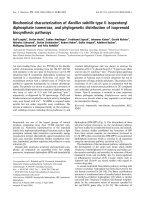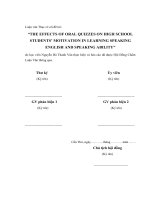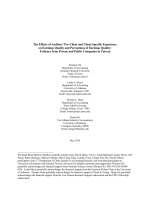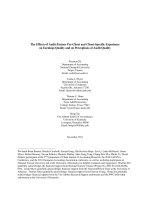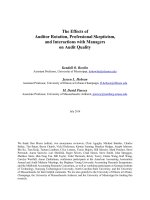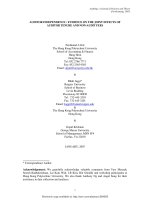effects of culture conditions on keratin degrading capability of bacillus subtilis k15
Bạn đang xem bản rút gọn của tài liệu. Xem và tải ngay bản đầy đủ của tài liệu tại đây (143.07 KB, 28 trang )
MINISTRY OF EDUCATION & TRAINING
CAN THO UNIVERSITY
BIOTECHNOLOGY RESEARCH & DEVELOPMENT
INSTITUTE
SUMMARY
BACHELOR OF SCIENCE THESIS
THE ADVANCED PROGRAM IN BIOTECHNOLOGY
EFFECTS OF CULTURE CONDITIONS ON
KERATIN DEGRADING CAPABILITY OF
BACILLUS SUBTILIS K15
SUPERVISOR
Dr. BUI THI MINH DIEU
STUDENT
TRUONG VAN THO
Student’s code: 3082631
Session: 34 (2008 - 2013)
Can Tho, 5/2013
APPROVAL
SUPERVISOR
Dr. BUI THI MINH DIEU
STUDENT
TRUONG VAN THO
Can Tho, May, 2013
PRESIDENT OF EXAMINATION COMMITTEE
Abstract
Microorganisms grow at different ranges of environmental
conditions. The aim of this study was to investigate the culture
conditions affecting keratin degradation by bacillus subtilis k15,
a feather-degrading mesophilic bacterium. The bacterium grew
with an optimum at pH 7.0–8.0 and 30–35oC, where maximum
bacterial growth, keratin degradation, keratinolytic activity and
soluble protein concentration were also observed. The keratin
degradation rate obtained 47% and 46% when the bacterium was
cultivated in a chicken feather medium contains 0.5% (w/v) skim
milk and yeast extract. Additionally, corn meal had a positive
influence on keratin degradation; the treatment degraded 48%
chicken feather meal, and showed 36.8% higher than the control.
The amount of chicken feather degraded higher in a medium
contains 1.2-1.8% (w/v) chicken feather meal. Besides, the
quantity of keratinolytic enzyme production depended on chicken
feather meal concentrations. Bacillus subtilis k15 degraded 3040% chicken feather meal after 5 days of incubation at 150 rpm;
bacterial growth, keratinolytic enzyme and soluble protein
concentration also got the highest value at that time. The
bacterium effectively degraded chicken feather meal and duck
feather meal, whereas hair human and pig fur showed relatively
low degradation rates. In short, Bacillus subtilis k15 presented
high keratinolytic activity and was very effective in keratin
degradation, providing potential use for biotechnological
processes of keratin degradation.
Keywords: Bacillus subtilis, chicken feather meal, keratin
degradation, keratinolytic enzyme
i
CONTENTS
Abstract ............................................................................................i
CONTENTS....................................................................................ii
1. INTRODUCTION....................................................................... 1
2. MATERIALS AND METHODS ................................................ 3
2.1. Materials .............................................................................. 3
2.2. Methods ............................................................................... 3
2.2.1. Effect of medium temperature on the keratin
degradation of Bacillus subtilis k15. ...................................... 3
2.2.2. Effect of medium pH on the keratin degradation of
Bacillus subtilis k15 ............................................................... 4
2.2.3. Effect of different nitrogen sources on the keratin
degradation of Bacillus subtilis k15 ....................................... 4
2.2.4. Effect of different carbon sources on the keratin
degradation of Bacillus subtilis k15 ....................................... 5
2.3.5. Effect of different chicken feather concentration on
the keratin degradation of Bacillus subtilis k15 ..................... 5
2.2.6. Time course of keratin degradation .............................. 6
2.2.7. The keratin degradation capability of Bacillus subtilis
k15 degraded the different keratin sources............................. 6
2.2.8. Methods determined characteristic samples in the
experiments............................................................................. 6
3. RESULTS AND DISCUSSION ............................................... 10
3.1. Effect of temperature on keratin degradation .................... 10
3.2. Effect of pH on keratin degradation................................... 11
3.3. Effect of nitrogen sources on keratin degradation ............. 13
3.4. Effect of carbon sources on keratin degradation................ 14
ii
3.5. Effect of chicken feather concentrations on keratin
degradation................................................................................ 16
3.6. Time course of keratin degradation ................................... 18
3.7. The ability of Bacillus subtilis k15 degrades different
keratin sources. ......................................................................... 19
4. CONCLUSIONS AND SUGGESTIONS ................................. 20
4.1. Conclusion ......................................................................... 20
4.2. Suggestions ........................................................................ 20
REFERENCES.............................................................................. 21
iii
1. INTRODUCTION
Environmental wastes are found in large quantities in many
countries. Feathers are largely produced as a waste byproduct at
poultry plants, reaching millions of tons per year worldwide.
Additionally, the accumulation of some of these wastes in nature
is considered to be a serious source of pollution and health
hazards. Therefore, their proper disposal may be considered as a
means of avoiding environmental pollution (Williams et al.,
1991).
Feathers are insoluble structural proteins cross-linked by
disulfide, hydrogen and hydrophobic bonds but could represent a
rich protein resource because they contain over 90% (w/w)
keratins. Keratins cannot be degraded by the usual proteolytic
enzymes such as pepsin, trypsin and papain (Kumar et al., 2007).
The mechanical stability of keratin and its resistance to
biochemical degradation depend on the tightly packed protein
chains in α-helix (α-keratin) and β-sheet (β-keratin) structures. In
addition, these structures are cross-linking by disulfide bridges in
cystines residues (Riffel et al., 2007).
Feathers are almost pure keratin protein, potential
alternative to more expensive dietary ingredients for animal
feedstuffs. Generally, they become feather meal used as animal
feed after undergoing physical and chemical treatments. These
processes require significant energy and also destroy certain
amino acids (Papadoulos and Ketelaars, 1986). An alternative and
attractive method for improving the digestibility of feathers is
biodegradation by keratinolytic microorganisms. A number of
keratinolytic microorganisms can produce keratinases which are
1
capable of degrading keratin. Various authors have reported that,
among the keratinolytic microorganisms, some species of
bacillus, actinomycetes and fungi are able to produce these
keratinases and peptidases (Sangali and Brandelli, 1999).
Bacteria are dependent on their environment to provide for
their basic needs. There are several factors that influence the
growth of bacteria: nutrition, oxygen, pH, temperature, and
moisture. Adverse conditions can alter their growth rate or kill
them. By understanding the factors affecting the growth of
bacteria we can know how to create an optimum condition in
which bacteria grow fastest and effectively degrade keratin.
Objectives:
Screening of cultural conditions affecting on the growth
and keratin-degrading capability of Bacillus subtilis k15
2
2. MATERIALS AND METHODS
2.1. Materials
−
Bacillus subtilis k15 from the research of Nguyễn Thị
Hồng Thẩm (2012), Biotechnology Research and Development
Institute, Can tho university.
−
The feather medium used contained the following (g/l):
0.5 NH4Cl, 0.5NaCl, 0.3 K2HPO4, 0.4 KH2PO4, 0.1MgCl2.6H2O,
and 10 chicken feather meals. The pH was adjusted to 7 before
sterilization. The agar medium added 20 agar and 0.1 yeast
extract. These samples were enriched in broth containing feather
meal (0.5 NH4Cl, 0.5 NaCl, 0.3 K2HPO4, 0.4 KH2PO4, 0.24
MgCl2.6H2O, 0.2 yeast extract and 10 chicken feather powder
(g/l), pH 7.5).
−
Chicken feathers were washed, dried, and hammer
milled prior to being added to the medium.
−
Chemicals and equipments in laboratory
2.2. Methods
2.2.1. Effect of medium temperature on the keratin
degradation of Bacillus subtilis k15.
This activity examined the keratin degrading capability of
bacteria at different temperature levels (25, 30, 35, 40, 45, and
50ºC). The capacity of degradation of keratin substrates was
tested on the feather medium. Using 250 ml Erlenmeyer flasks
added 50 ml medium, sterilized at 121ºC in 15 minutes,
inoculated 1ml of bacterial suspension (107CFU/ml) into flasks,
cultivated for 5 days with constant shaking at 150 rpm. After 5
days
determined
bacterial
growth,
keratinolytic activity and protein.
3
keratin
degradation,
2.2.2. Effect of medium pH on the keratin degradation of
Bacillus subtilis k15
This activity screened the keratin degrading capability of
bacteria at different pH levels (4, 5, 6, 7, 8, 9, 10, 11). The
capacity of degradation of keratin substrates was tested on the
feather medium. 50 ml of the medium was dispensed into each of
250-ml Erlenmeyer flasks followed by inoculation with 1ml of
Bacillus subtilis k15 culture (107CFU/ml). Flasks were sterilized
at 121ºC in 15 minutes before inoculating the bacteria.
Cultivations were performed at optimum temperature at
experiment temperature and 150 rpm for 5days. All samples were
determined bacterial growth, keratin degradation, keratinolytic
activity, protein.
2.2.3. Effect of different nitrogen sources on the keratin
degradation of Bacillus subtilis k15
The feather medium was supplemented with 0.5% (w/v)
skim milk, yeast extract, urea, NH4Cl, NaNO3, soybean to study
the effects of addition different nitrogen sources on keratin
degradation. The capacity of degradation of keratin substrates was
tested on the feather medium; pH was adjusted to optimum pH.
50 ml of the medium was dispensed into each of 250-ml
Erlenmeyer flasks followed by inoculation with 1ml of Bacillus
subtilis k15 culture (107CFU/ml). Flasks were sterilized at 121ºC
in 15 minutes before inoculating the bacteria. Cultivations were
performed at optimum temperature and 150 rpm for 5 days. All
samples were determined bacterial growth, keratin degradation,
keratinolytic activity, protein.
4
2.2.4. Effect of different carbon sources on the keratin
degradation of Bacillus subtilis k15
The feather medium was supplemented with 1% (w/v)
glucose, sucrose, starch, molasses and corn meal to study the
effects of addition different carbon sources on keratin
degradation. The capacity of degradation of keratin substrates was
tested on the feather medium; pH was adjusted to optimum pH
before sterilization. 50 ml of the medium was dispensed into each
of 250 ml Erlenmeyer flasks followed by inoculation with 1ml of
Bacillus subtilis k15 culture (107CFU/ml). Flasks were sterilized
at 121ºC in 15 minutes before inoculating the bacteria.
Cultivations were performed at optimum temperature and 150
rpm for 5days. All samples were determined bacterial growth,
keratin degradation, keratinolytic activity, protein.
2.3.5. Effect of different chicken feather concentration on the
keratin degradation of Bacillus subtilis k15
The feather medium was supplemented with 0.2%, 0.4%,
0.6%, 0.8%, 1%, 1.2%, 1.4%, 1.8%, 2%(w/v) chicken feather
powder to study the effects of addition different chicken feather
concentration on keratin degradation. The capacity of degradation
of keratin substrates was tested on the feather medium; pH was
adjusted to optimum pH. 50 ml of the medium was dispensed into
each of 250ml Erlenmeyer flasks followed by inoculation with
1ml of Bacillus subtilis k15 culture (107CFU/ml). Flasks were
sterilized at 121ºC in 15 minutes before inoculating the bacteria.
Cultivations were performed at optimum temperature and 150
rpm for 5 days. All samples were determined bacterial growth,
keratin degradation, keratinolytic activity, protein.
5
2.2.6. Time course of keratin degradation
The capacity of degradation of keratin substrates was tested
on the feather medium; pH was adjusted to optimum pH before
sterilization. 50 ml of the medium was dispensed into each of
250-ml Erlenmeyer flasks followed by inoculation with 1ml of
Bacillus subtilis k15 culture (107CFU/ml). Flasks were sterilized
at 121ºC in 15 minutes before inoculating the bacteria.
Cultivations were performed at optimum temperature and 150
rpm from 1 to 7 days. All samples were determined bacterial
growth, keratin degradation, keratinolytic activity, protein every
day.
2.2.7. The keratin degradation capability of Bacillus subtilis
k15 degraded the different keratin sources.
The feather medium was supplemented with 1%(w/v) duck
feather, chicken feather, human hair, goat hair, pig fur to study
the effects of addition different keratin sources on keratin
degradation. The capacity of degradation of keratin substrates was
tested on the feather medium; pH was adjusted to optimum pH.
50 ml of the medium was dispensed into each of 250-ml
Erlenmeyer flasks followed by inoculation with 1ml of Bacillus
subtilis k15 culture (107CFU/ml). Flasks were sterilized at 121ºC
in 15 minutes before inoculating the bacteria. Cultivations were
performed at optimum temperature and 150 rpm for 5 days. All
samples were determined bacterial growth, keratin degradation,
keratinolytic activity, protein.
2.2.8. Methods determined characteristic samples in the
experiments.
6
a. Determination of bacterial growth (Nguyễn Đức Lượng et
al., 2003)
Bacterial growth was determined by total plate count on
nutrient agar medium.
b. Determination of keratin degradation
Feather in cultures was harvested by filtration with filter
paper, washed twice with distilled water and dried at 70oC to
constant weight. The percentage of keratin degradation was
calculated from the differences in residual feather dry weight
between a control (feather without bacterial inoculation) and
treated sample (bacteria were inoculated)
c. Determination of kerinolytic activity
Azokeratin (Joshi el at., 2007):
Azokeratin was prepared by a similar method Ball-milled
feather powder was prepared. 1 g portion of the chicken feather
powder (the keratin source) was placed in a 100-ml round
bottomed reaction flask with 20 ml of sterilized water. The
suspension was mixed with a magnetic stirrer. Two ml of 10%
NaHCO3 (w/v) were mixed into the feather suspension. In a
separate 10-ml tube, 174 mg of sulfanilic acid were dissolved in 5
ml of 0.2 N NaOH. Sixty-nine mg of NaNO2 were then added to
the tube and dissolved. The solution was acidified with 0.4 ml of
5 N HCl, mixed for 2 min and neutralized by adding in 0.4ml of 5
N NaOH This solution was added to the feather keratin
suspension and mixed for 10 min. The reaction mixture was
filtered and the insoluble azo-keratin was rinsed thoroughly with
deionized water. The azo-keratin was suspended in water and
shaken at 50°C, for 2 hr and filtered again. This wash cycle was
7
repeated until the pH of the filtrate reached 6.0-7.0 and the
spectrophotometric absorbance of the washing at 450 nm was less
than 0.01. Finally, the wash cycles were repeated at least twice
using 50mM potassium phosphate buffer, pH 7.5. The azokeratin
was washed once again with water and dried in vacuum overnight
at 50°C.
Extraction of Enzyme (Park and Son, 2009)
Bacillus subtilis k15 incubated in feather medium at
different culture conditions.
Filtration: The culture medium was filtered through filter
paper to remove undegraded residues.
Centrifugation: The filtrate was then subjected to
centrifugation at 12,000 rpm for 5 min to remove bacterial
residue. It was used as the crude enzyme keratinase.
This procedure tested the keratinolytic activity
5 mg of azokeratin was added to a 1.5 ml centrifuge tube
along with 0.8ml of 50 mM potassium phosphate buffer, pH 7.5.
This mixture was agitated until the azo-keratin was completely
suspended. A 0.2ml aliquot of supernatant of crude enzyme was
added to the azokeratin, mixed and incubated for 15 min at 50°C
with shaking. The reaction was terminated by adding 0.2 ml of
10% trichloroacetic acid (TCA). Control sample was prepared by
adding the TCA to a reaction mixture before the addition of
enzyme. The absorbance of the filtrate was measured at 450.
enzyme solution 1 unit of keratinase activity was defined as a
0.01 unit increase in the absorbance at 450 nm as compared to the
control after 15 min of reaction.
d. Protein determination
8
Protein concentration was measured by the method of
Bradford (1976), using bovine serum albumin (BSA) as standard.
9
3. RESULTS AND DISCUSSION
3.1. Effect of temperature on keratin degradation
14
45
Degradation (%)
35
b
a
ab
a
12
b
10
30
8
25
20
c
b
c
15
6
c
4
Growth (CFU/ml, 109)
a
40
10
5
2
d
d
45
50
0
0
25
30
35
40
Tem perature
Feather Degradation
Bacterial Growth
Figure 1. Effect of temperature on feather degradation
and bacterial growth
Note: The different letters denote a statistically significant difference at 5%.
As shown in figure 1, the higher keratin degradation rate
was obtained from 25oC to 40oC. The degradation rate got the
highest at 30oC and 35oC, were 38% and 37% after 5 days,
respectively. Keratin degradation decreased gradually from 40oC50oC. The Bacillus subtilis k15 had ability to grow from 25 to
40oC and the optimum growth temperature was determined to be
30-35oC, the bacterial population was 1010CFU/ml at optimum
conditions. At high temperature 45-50oC, bacterial growth was
reduced so keratin degradation decrease.
The highest bacterial population was observed at 30oC. The
highest keratinolytic activity also got 14 U/ml at this condition.
10
At 30oC and 35oC, soluble protein gained the highest
concentration, were 29 µg/ml and 26 µg/ml, respectively. The
lowest keratinolytic activity and soluble protein were observed in
too low or high temperature. The other study also showed that
keratinase production and keratin degradation of Bacillus sp. were
observed the highest during cultivation in the range 30–40oC
(Tom et al., 2011).
Table 5. Effect of temperature on keratinolytic activity
and soluble protein.
Temperature Keratinolytic activity
o
( C)
( U/ ml)
c
Protein
(µg/ml)
25
6
10c
30
14a
29a
35
11b
26a
40
9b
17b
45
4c
20b
50
2d
12c
Note: The different superscript letters denote a statistically significant difference
at 5%.
3.2. Effect of pH on keratin degradation
The optimum pH for keratin degradation was determined
by growing Bacillus subtilis k15 at pH 4.0–11.0 and 30oC. As
shown fig. 2, the keratin degradation increased gradually up to pH
7, after that it decreased from pH 8-11. At the optimum pH 7-8,
40% feather was completely destroyed. Besides, the bacterial
population at pH 7-8 was significantly higher at pH 4-5 and pH
11
10-11. The highest population growth was obtained between pH 7
and pH 8, was nearly 1010CFU/ml.
45
18
a
a
b
Degradation (%)
35
c
30
e
14
12
a
cd
a
de
25
20
16
10
b
cb
cd
b
8
c
15
10
6
d
4
d
5
Growth (CFU/ml, 109)
40
2
0
0
4
5
6
7
pH
8
9
Feather degradation
10
11
Bacterial growth
Figure 2. Effect of pH on feather degradation and
bacterial growth
Note: The different letters denote a statistically significant difference at 5%.
The keratinolytic activity was also higher in neutral range
of pH 7-8; the highest keratinolytic enzyme production was
obtained at pH 7 and 8, was 12-14 U/ml. However, the highest
soluble protein was determined at pH 10-11; in alkaline
condition, protein was produced effectively.
B. licheniformis PWD-1 exhibited best keratinase activity
and higher degradation ability under neutral conditions (Wang
and Shih, 1999), additionally Bacillus sp. tended to do best in pH
6-8 (Pandian et al., 2012). The results indicated that Bacillus
subtilis k15 grew best in neutral pH, which can be more
12
efficiently applied to degrade keratin in the neutral pH. This
bacterium was inhibited in high alkaline and acid condition.
Table 6.
Effect of pH on keratin degradation and
bacterial growth
pH
Protein
Keratinolytic activity
(µ
µg/ml)
(U/ml)
4
11
f
4c
5
17fe
5c
6
28cd
9b
7
35c
14a
8
37bc
12ab
9
24ed
10b
10
63a
6c
11
45b
6c
Note: The different superscript letters denote a statistically significant difference
at 5%.
3.3. Effect of nitrogen sources on keratin degradation
The effect of nitrogen sources on keratin degradation in
Table 7. Bacillus subtilis k15 degraded 32% chicken feather meal
when it cultivated in medium containing none nitrogen
complements. This result suggests that chicken feather as the
sole carbon and energy source supports bacterial growth.
Additionally, yeast extract, NH4Cl, skim milk, soybean had a
positive influence on keratin degradation, resulting in 46%, 36%,
47%, 41% whereas control was only 32%. On the other hand,
urea and NaNO3 were no effect of keratin degradation. Table 7
shows that keratinolytic enzyme production increased with
13
complementing skim milk, 29 U/ml. The bacterial growth and
soluble protein concentration obtained the highest in the media
containing yeast extract and skim milk. Park and Son (2009)
reported that the present of skim milk and yeast extract in the
medium increase keratin degradation and keratinolytic activity of
Bacillus megaterium F7-1.
Table 7: Effect of nitrogen sources on keratin
degradation
Keratin
Bacterial
kertinolytic
degradation
growth
enzyme
(0.5% w/v)
(%)
(CFU/ml, 108)
( U/ ml)
(µg/ml)
yeast
51e
118c
26d
91e
Urea
36b
88ab
18bc
27bc
NH4Cl
41c
99b
15ab
31c
Skim milk
52e
113c
29d
174f
soybean
46d
91b
21c
78d
NaNO3
37b
76a
12a
4a
None
37b
87ab
14a
18b
Nitrogen
Control_none
bacteria
Protein
5a
Note: The different superscript letters denote a statistically significant difference
at 5%.
3.4. Effect of carbon sources on keratin degradation
The influence of the addition of various carbon sources
supplement is shown in Table 8. The result showed glucose
14
slightly increase or no effect of keratin degradation. Molasses was
inhibited bacterial growth, so it decreased keratin degradation.
However, starch, soybean and sucrose were positive effect of
keratin degradation. Similar result was also reported for
streptomyces albidus E4 (Kansoh et al., 2009). Additionally,
soybean obtained the appreciable level of degrading keratin,
resulting 48%. The bacterial growth and keratinolytic activity in
the medium containing soybean were significantly higher
compare to the other carbon sources.
Table
8:
Effect
of
carbon
sources
on
feather
degradation
Keratin
Bacterial
kertinolytic
degradation
growth
enzyme
(1% w/v)
(%)
(CFU/ml,108)
( U/ ml)
(µg/ml)
Glucose
41c
81a
14ab
34a
Sucrose
49d
94ab
17c
55b
Starch
48d
123cd
20d
63b
Molasses
34b
82a
13a
50b
Corn meal
53e
135d
20d
81c
None
40c
107bc
16bc
55b
carbon
Control_none
bacteria
Protein
5a
Note: The different superscript letters denote a statistically significant difference
at 5%.
15
3.5. Effect of chicken feather concentrations on keratin
degradation
The effect of different chicken feather concentrations on
keratinolytic enzyme production and keratin degradation is shown
in Figure 3. The keratin degradation rate decreased when chicken
feather concentration increased from 0.2%-2%. However, the
amount of keratinolytic enzyme production depended on feather
concentration. Keratinolytic enzyme production increased as the
amount of feather increased (0.2–1.8%, w/v); but when the
concentration was raised to 1.2% (w/v), enzyme production
slightly decreased. The highest enzyme production was obtained
at 1.8% (w/v) feather.
24
a
70
a
Degradation (%)
60
a
18
a
50
15
bc
bc
b
bc
40
12
c
30
20
21
9
d
Enzyme activity (U/ml)
80
6
10
3
0
0
0.2
0.4
0.6
0.8
1
1.2
1.4
1.6
1.8
2
Fe athe r conce ntration (%)
Bacterial growth
keratinolytic activity
Figure 3. Effect of feather concentrations on feather
degradation and enzyme activity
Note: The different letters denote a statistically significant difference at 5%.
16
On the other hand, the degrading feather weight increased
gradually when feather concentration raised to 1.8%, after that it
decreased when feather concentration go up 2%. The bacterial
growth and soluble protein also increased in the medium
contained 0.2-1.2% (w/v) chicken feather meal. The maximum
growth and protein were obtained at 1-1.2%. The media contained
high feather concentration inhibited bacterial growth. The results
could be the cause of high feather concentration increased
medium viscosity which possibly resulting in oxygen limitation
for bacterial growth (Park and Son, 2009)
Table 9: Effect of feather concentration on feather
degradation of Bacillus subtilis k15
Feather
Feather degradation
Protein
Growth
concentration (%)
(gam)
(µg/ml)
(CFU/ml)
0,2
0,0711f
16f
25g
0,4
0,0988e
26de
38f
0,6
0,1353d
24ef
79d
0,8
0,1563d
42b
88c
1,0
0,1908c
57a
94ab
1,2
0,2195ab
41bc
97a
1,4
0,2366a
38bc
93abc
1,6
0,2263ab
40bc
89bc
1,8
0,2288ab
40bc
75d
2,0
0,2059cb
34cd
66e
Note: The different superscript letters denote a statistically significant difference
at 5%.
17
3.6. Time course of keratin degradation
The time course of feather degradation by Bacillus subtilis
k15 culture grown in feather medium is shown in Fig.4. The
maximum keratinolytic activity of Bacillus subtilis k15 was about
21 U/ml after 5 days of cultivation. The keratin degradation was
increase gradually from 1 day to 7 days; after 5 days 37% feather
was degraded completely. Besides, bacterial growth obtained
maximum at 5 days and decrease at 7 days. The maximum
45
27
40
24
35
21
30
18
25
15
20
12
15
9
10
6
5
3
0
0
1
2
Degradation
3
4
Tim e (days)
Protein
5
Growth
6
7
keratinolytic activity
Figure 4: Time course of keratin degradation
18
Enzyme activity (U/ml) & Growth (CFU/ml, 109)
Degradation (%) & protein (µg/ml)
soluble protein got 35µg/ml after 5 days cultivation.
3.7. The ability of Bacillus subtilis k15 degrades different
keratin sources.
45
40
38
keratin degradation (%)
35
30
30
24
25
20
18
15
13
10
5
0
pig fur
human hair
chicken feather
duck feather
goat hair
ke ratin sou rce s
Figure 5’: The ability of Bacillus subtilis k15 degrades
different keratin sources
The ability of Bacillus subtilis k15 degrades different
keratin sources medium is was also investigated using chicken
feather, duck feather, human hair, goat hair and pig fur. The result
showed chicken feather and duck feather were completely
degraded 38% and 30% after 5 days. The pig fur and human hair
had lowest degradation rate. The human hair was degraded 13%
only. The Bacillus subtilis k15 effectively degrade chicken and
duck feather, but low effect of degradation on human hair and pig
pur.
19
4. CONCLUSIONS AND SUGGESTIONS
4.1. Conclusion
−
Bacillus
subtilis
k15
grew
with
an
optimum
o
temperature at 30-35 C.
−
High acid and alkaline condition inhibited bacterial
growth, so ability of keratin degradation decrease. Bacillus
subtilis k15 degraded chicken feather meal and grew favorably in
neutral condition.
−
Yeast extract, skim milk (0.5%) and corn meal (1%)
effectively increased bacterial growth, keratinase, keratin
degradation and soluble protein.
−
The maximum chicken feather weight degraded in the
medium contained 1.2-1.8% (w/v) chicken feather meal.
Additionally, the amount of keratinolytic enzyme production
depended on chicken feather concentration.
−
The bacterial growth and keratinase gained highest at 5
−
The Bacillus subtilis k15 effectively degrade chicken
days.
and duck feather.
4.2. Suggestions
−
Comparison between azokeratin and azure (be done
with commerce) to test azokeratin quality.
−
To study enzyme keratinase from Bacillus subtilis k15.
−
A further study biotechnological process to apply
Bacillus subtilis k15 for keratin waste degradation is in a practice.
20

